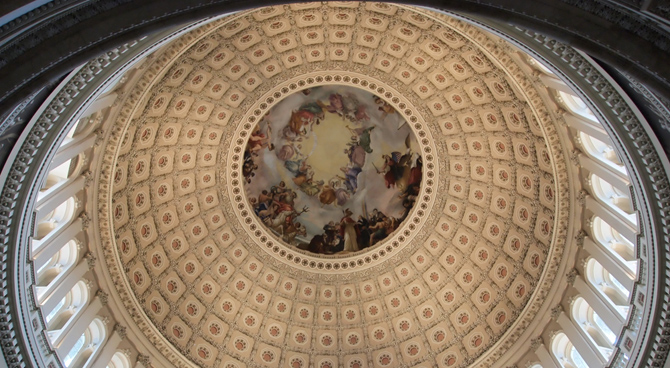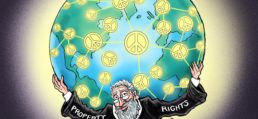Two-thirds of the world’s population lacks access to a formal system of property rights.
By Phil Gramm and Hernando de Soto
Jan. 25, 2018 7:11 pm ET
For a long time, Western economists failed to appreciate the relationship between private property rights and economic development. Karl Marx saw private property as the source of wealth and called for its elimination to promote equality. A century and a half later, we know that a country without a formal system for registering property rights limits its own economic development and prevents its citizens from realizing their full potential. It’s a simple yet startling fact: The road to economic development runs through the county clerk’s office at the local courthouse.
The great economic divide in the world today is between the 2.5 billion people who can register property rights and the five billion who are impoverished, in part because they can’t. Consider what happens without a formal system of property rights: Values are reduced for privately owned assets; wages are devalued for workers using these assets; owners are denied the ability to use their assets as collateral to obtain credit or as a credential to claim public services; and society loses the benefits that accrue when assets are employed for their highest and best purpose. The Institute for Liberty and Democracy, founded by Hernando de Soto in 1979, estimates that two-thirds of the world’s population lacks access to a formal system of property rights, resulting in undeveloped resources and assets worth an estimated $170 trillion, or 63% of the value of the assets of the U.S.
Increasingly sophisticated data from surveys, satellite photos and the Global Positioning System have resulted in organized knowledge about the location of every visible asset on earth. Yet outside the developed world and some advanced regions of developing countries, there are no accessible records detailing who owns those assets.
Forty years ago one of us—Hernando de Soto—discovered that even in the most primitive societies records exist on who owns what. Based on this discovery, ILD undertook an organized effort in Peru to begin to assimilate and formalize these records to establish a registry of property ownership.
In 1980 the communist-terrorist insurgency known as the Shining Path won support among the poor indigenous people of Peru by enforcing primitive property rights at the point of a gun. We first collaborated in 1990 when Peru sought American assistance to replace the gun with the rule of law by officially recognizing that the indigenous Peruvians’ primitive property records were legal proof of ownership. At that point the Shining Path controlled 60% of Peru’s territory, and the RAND Corp. was predicting that Lima would fall as early as 1992.
One of us— Phil Gramm, then a U.S. senator—helped obtain funding for the ILD’s property-registration effort, and ultimately for the formation of an alliance between Peru’s army and the farmers and miners who were eager to fight for their newly won property rights. By providing these indigenous people with formal proof of property ownership, property-rights registration reached through their wallets and touched their hearts and minds. With a conviction that comes only from defending your own property, indigenous Peruvians overwhelmed the communist terrorists.
Shining Path leaders surrendered, opting for the safety of prison over the wrath of Peru’s indigenous poor. The terrorists’ commander, Abimael Guzmán, specifically blamed the property rights “conceived and implemented by Hernando de Soto” and his American supporters for Shining Path’s defeat. The U.S. has never won a war against communism or terrorism with so little blood and treasure, but of course we have seldom had an ally like private property rights on our side.
Bringing greater legal certainty to property ownership can produce huge economic gains. In 1990 the state-owned Peruvian telecommunications company CPT was valued on the Lima Stock Exchange at $53 million. The government wanted to sell CPT to foreign investors but couldn’t, because Peruvian titles to the company’s assets did not meet global standards. CPT initiated a program using ILD guidelines to research title records and formally establish its property rights. Within three years CPT was sold on the world market for $2 billion—roughly 38 times its previous value.
In 2010, Mohamed Bouazizi, a street vendor, triggered the Arab Spring by setting himself on fire in the Tunisian city of Sidi Bouzid. A comprehensive 2013 ILD study found that he and others who self-immolated were protesting not religious issues but the absence of property rights and the rule of law. Based on Peru’s success, and a growing awareness of the importance of property rights, sporadic efforts are now under way all over the developing world to collect records on property ownership. But the difficulty of gathering and maintaining those records in an accessible and easily updatable form has proved an obstacle.
Fortunately there is a new technology that could make a global property-rights registration system feasible. Patrick Byrne, an e-commerce pioneer and the CEO of Overstock.com, has committed a professional staff and significant resources to modernizing the collection and maintenance of property-rights records on a global scale. Blockchain is an especially promising technology because of its record-keeping capacity, its ability to provide access to millions of users, and the fact that it can be constantly updated as property ownership changes hands.
If Blockchain technology can empower public and private efforts to register property rights on a single computer platform, we can share the blessings of private-property registration with the whole world. Instead of destroying private property to promote a Marxist equality in poverty, perhaps we can bring property rights to all mankind. Where property rights are ensured, so are the prosperity, freedom and ownership of wealth that brings real stability and peace.
Mr. Gramm, a former chairman of the Senate Banking Committee, is a visiting scholar at the American Enterprise Institute. Mr. de Soto is author of “The Mystery of Capital” and a former CEO of UEC, Switzerland’s largest consulting engineering firm.
Copyright ©2019 Dow Jones & Company, Inc. All Rights Reserved. 87990cbe856818d5eddac44c7b1cdeb8
Appeared in the January 26, 2018, print edition.





